Harvesting
Harvesting beetroot in the United Kingdom
Storage
All vegetables benefit from proper post harvest care. A large proportion of vegetables and perishable foods are lost after harvest during the storage period. These losses may be as high as thirty to fifty percent in developing countries where adequate cold storage facilities are not available. The main causes of loss include spoilage caused by moisture, moulds, micro-organisms and vermin.[35]
Temporary storage of potatoes in the Netherlands
Proper post-harvest storage aimed at extending and ensuring shelf life is best effected by efficient cold chain application.[36] Cold storage is particularly useful for vegetables such as cauliflower, eggplant, lettuce, radish, spinach, potatoes and tomatoes, the optimum temperature depending on the type of produce. There are temperature-controlling technologies that do not require the use of electricity such as evaporative cooling.[6] Storage of fruit and vegetables in controlled atmospheres with high levels of carbon dioxide or high oxygen levels can inhibit microbial growth and extend storage life.[37]
The irradiation of vegetables and other agricultural produce by ionizing radiation can be used to preserve it from both microbial infection and insect damage, as well as from physical deterioration. It can extend the storage life of food without noticeably changing its properties.[38]
Preservation
The objective of preserving vegetables is to extend their availability for consumption or marketing purposes. The aim is to harvest the food at its maximum state of palatability and nutritional value, and preserve these qualities for an extended period. The main causes of deterioration in vegetables after they are gathered are the actions of naturally-occurring enzymes and the spoilage caused by micro-organisms.[39] Canning and freezing are the most commonly used techniques, and vegetables preserved by these methods are generally similar in nutritional value to comparable fresh products with regards to carotenoids, vitamin E, minerals and dietary fiber.[40]
Bean field and canning factory, New Jersey, US
Freezing vegetables and maintaining their temperature at below −10 °C (14 °F) will prevent their spoilage for a short period, whereas a temperature of −18 °C (0 °F) is required for longer-term storage. The enzyme action will merely be inhibited, and blanching of suitably sized prepared vegetables before freezing mitigates this and prevents off-flavors developing. Not all micro-organisms will be killed at these temperatures and after thawing the vegetables should be used promptly because otherwise, any microbes present may proliferate.[41]
Sun-drying tomatoes in Greece
High levels of both sugar and salt can preserve food by preventing micro-organisms from growing. Green beans can be salted by layering the pods with salt, but this method of preservation is unsuited to most vegetables. Marrows, beetroot, carrot and some other vegetables can be boiled with sugar to create jams.[39] Vinegar is widely used in food preservation; a sufficient concentration of acetic acid prevents the development of destructive micro-organisms, a fact made use of in the preparation of pickles, chutneys and relishes.[39] Fermentation is another method of preserving vegetables for later use. Sauerkraut is made from chopped cabbage and relies on lactic acid bacteria which produce compounds that are inhibitory to the growth of other micro-organisms.[6]
Top producers
Vegetable shop in India
Vegetables in a supermarket in the United States
Vegetables in a supermarket in Canada
| Country | Area cultivated thousand hectares (2,500 acres) |
Yield thousand kg/ha (89 lbs/acre) |
Production thousand tonnes (1,100 short tons) |
|---|---|---|---|
| China | 23,458 | 230 | 539,993 |
| India | 7,256 | 138 | 100,045 |
| United States | 1,120 | 318 | 35,609 |
| Turkey | 1,090 | 238 | 25,901 |
| Iran | 767 | 261 | 19,995 |
| Egypt | 755 | 251 | 19,487 |
| Italy | 537 | 265 | 14,201 |
| Russia | 759 | 175 | 13,283 |
| Spain | 348 | 364 | 12,679 |
| Mexico | 681 | 184 | 12,515 |
| Nigeria | 1844 | 64 | 11,830 |
| Brazil | 500 | 225 | 11,233 |
| Japan | 407 | 264 | 10,746 |
| Indonesia | 1082 | 90 | 9,780 |
| South Korea | 268 | 364 | 9,757 |
| Vietnam | 818 | 110 | 8,976 |
| Ukraine | 551 | 162 | 8,911 |
| Uzbekistan | 220 | 342 | 7,529 |
| Philippines | 718 | 88 | 6,299 |
| France | 245 | 227 | 5,572 |
| Total world | 55,598 | 188 | 1,044,380 |

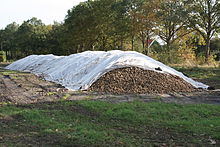
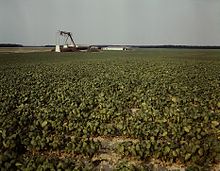


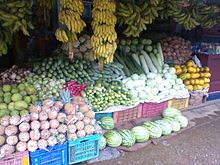
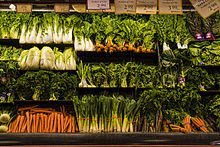
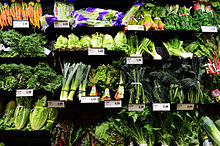
No comments:
Post a Comment